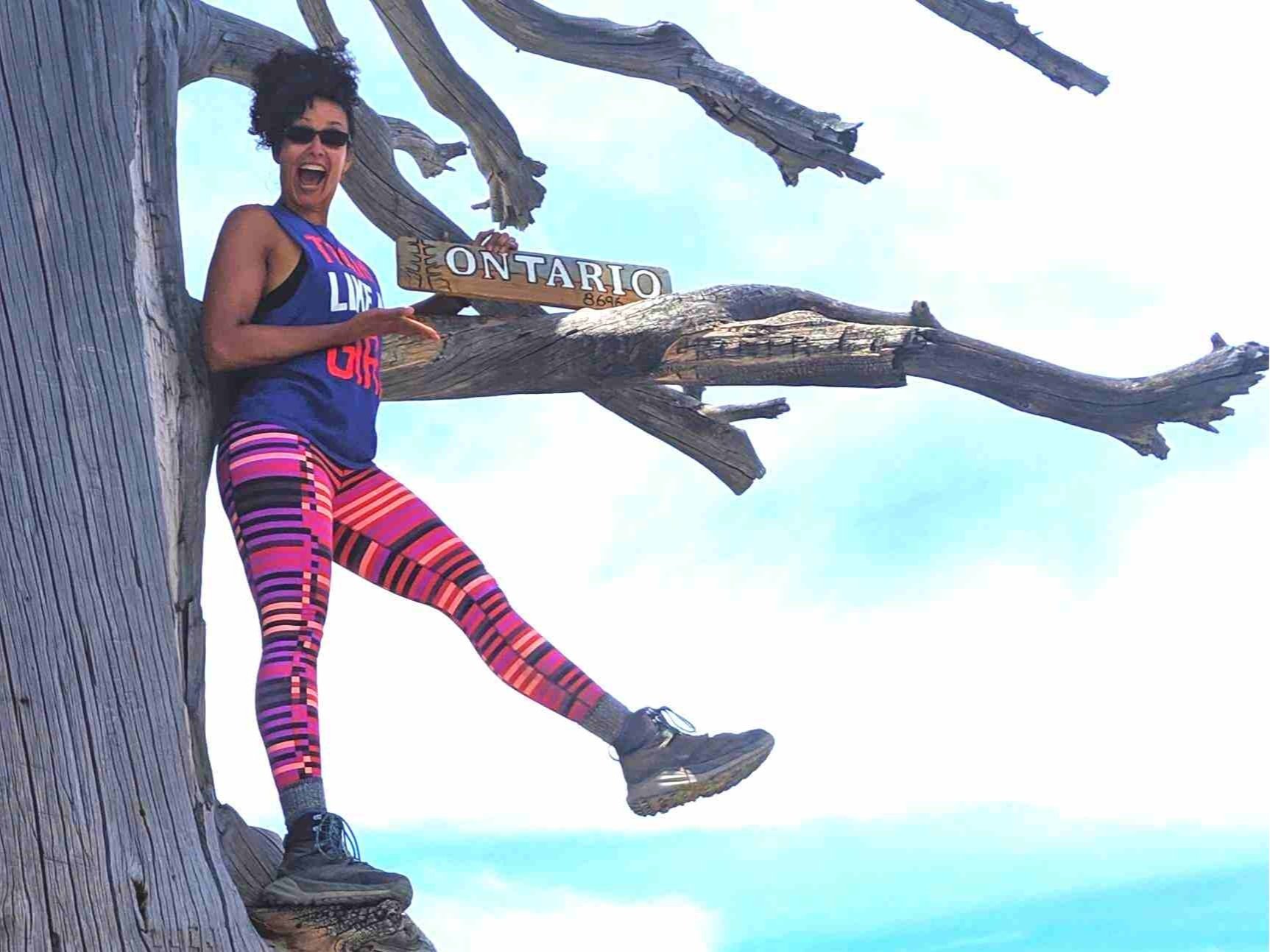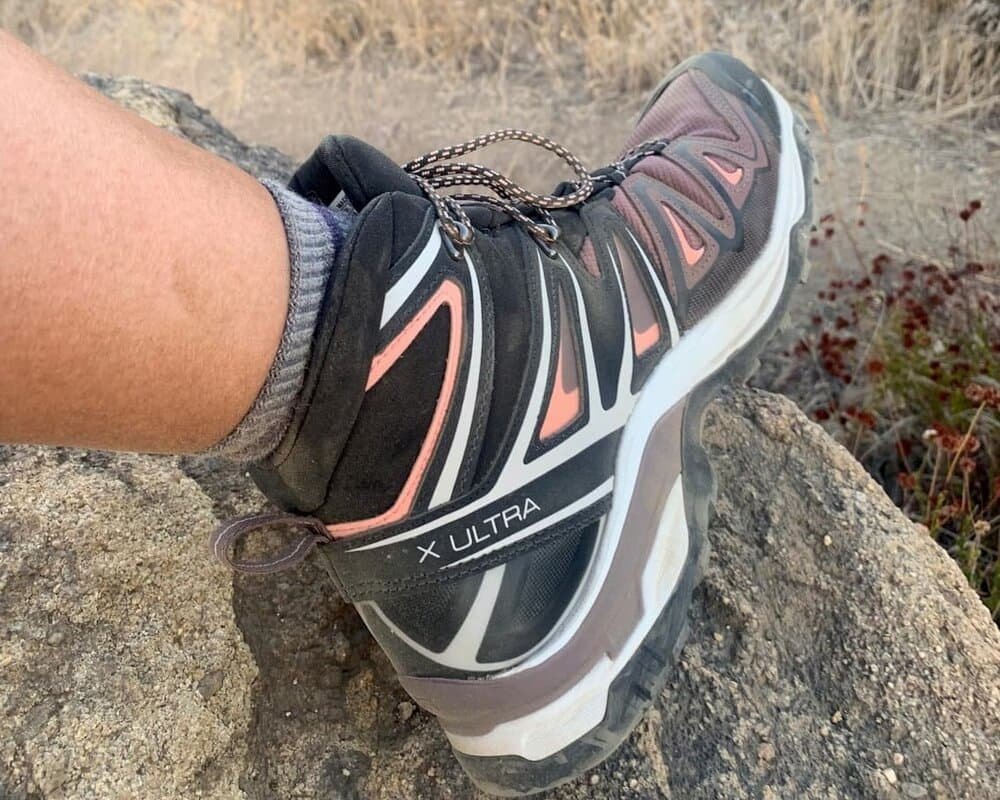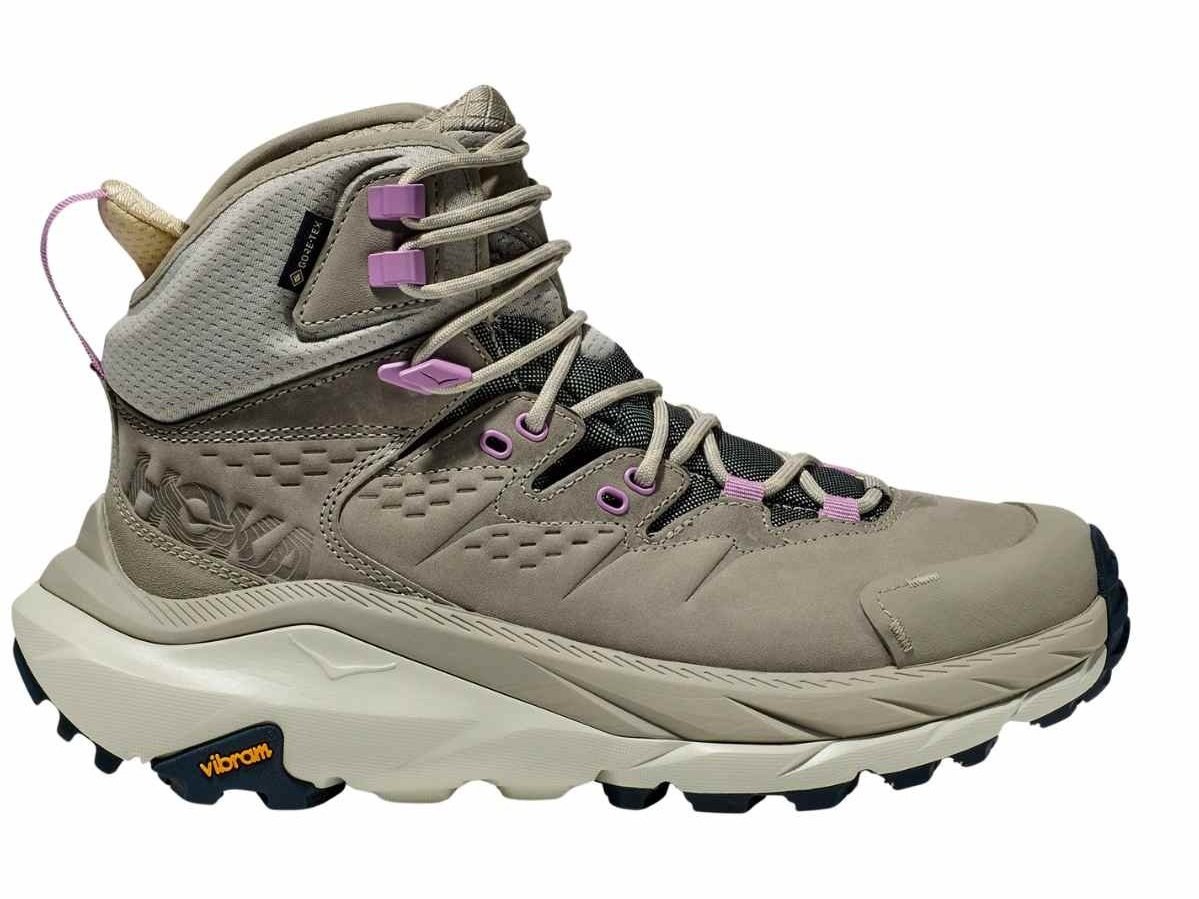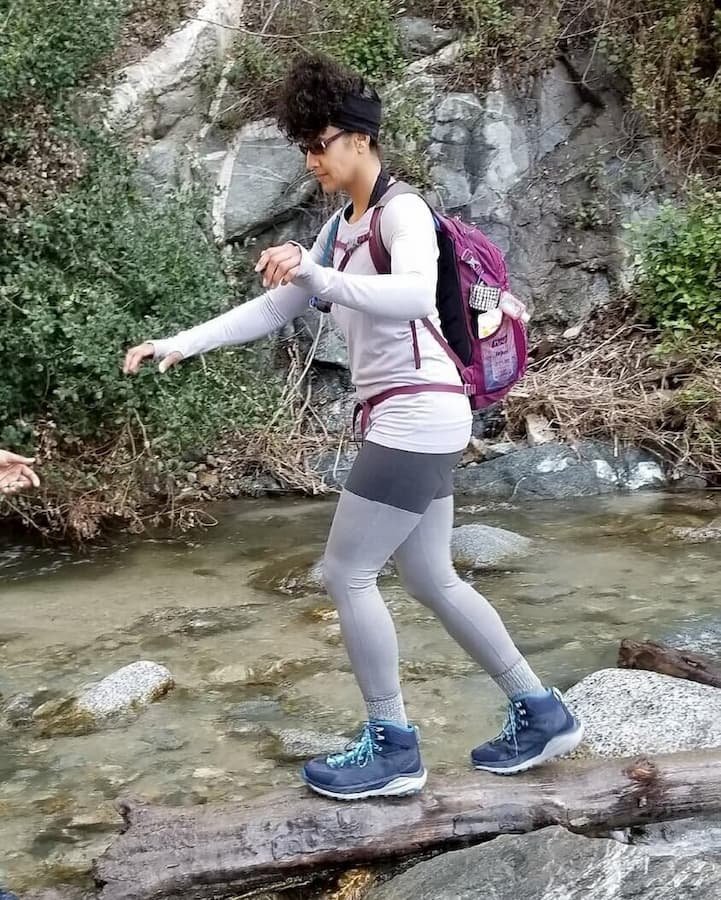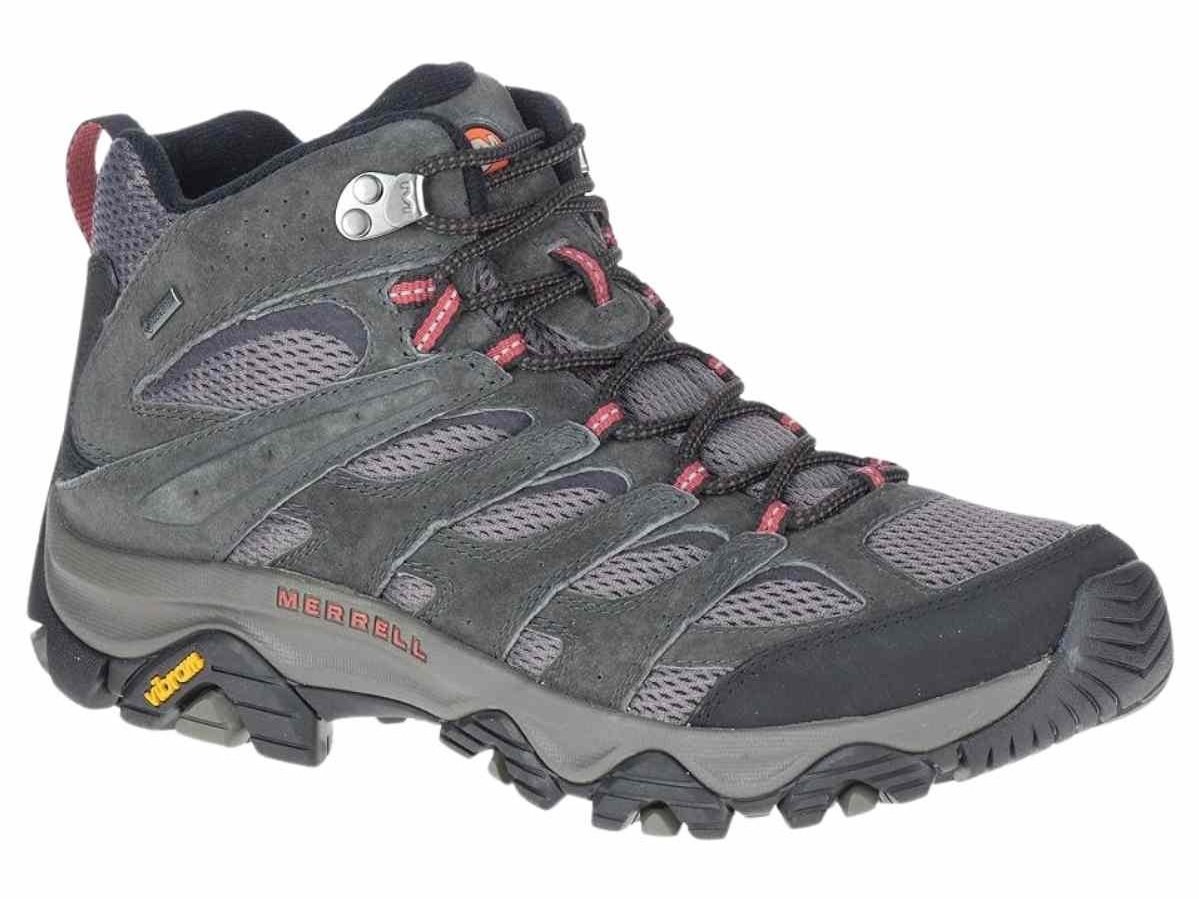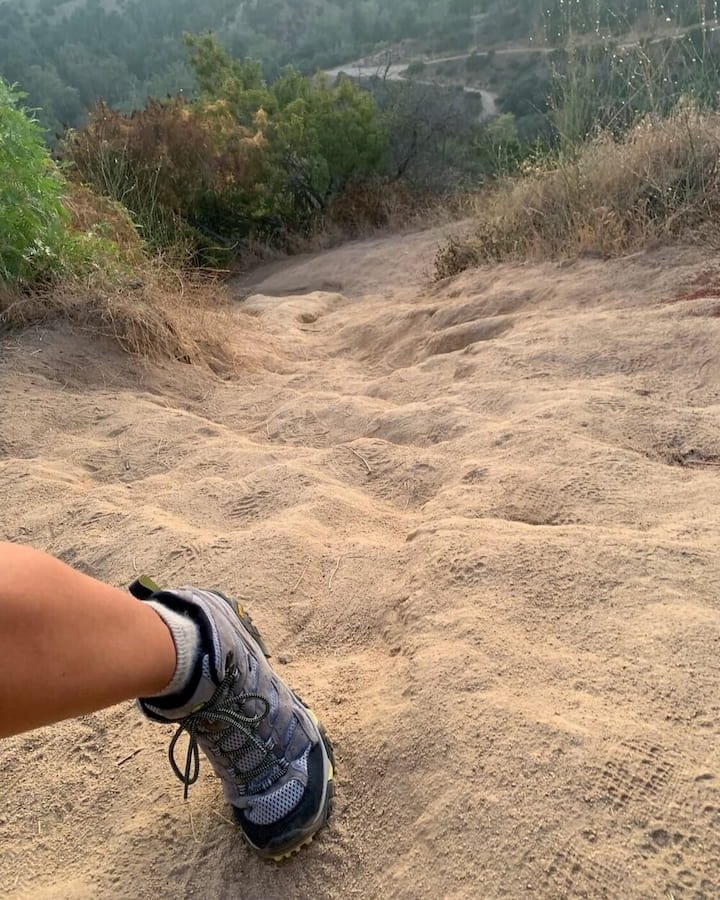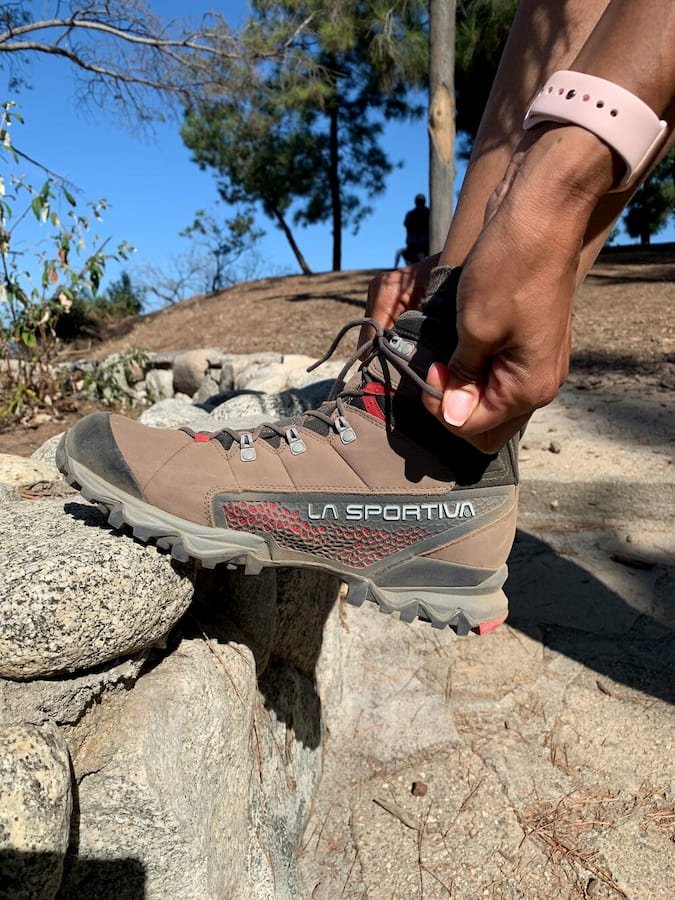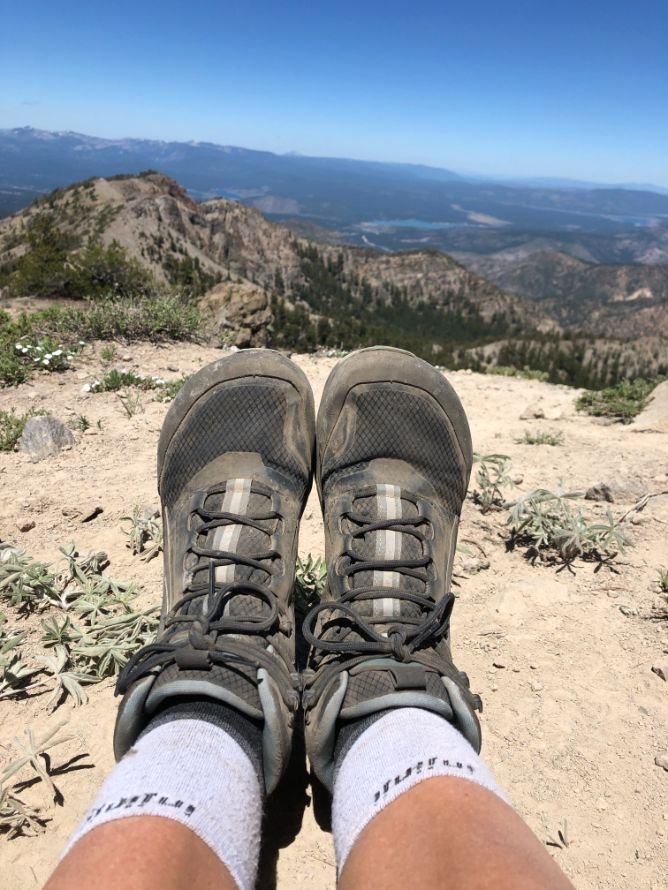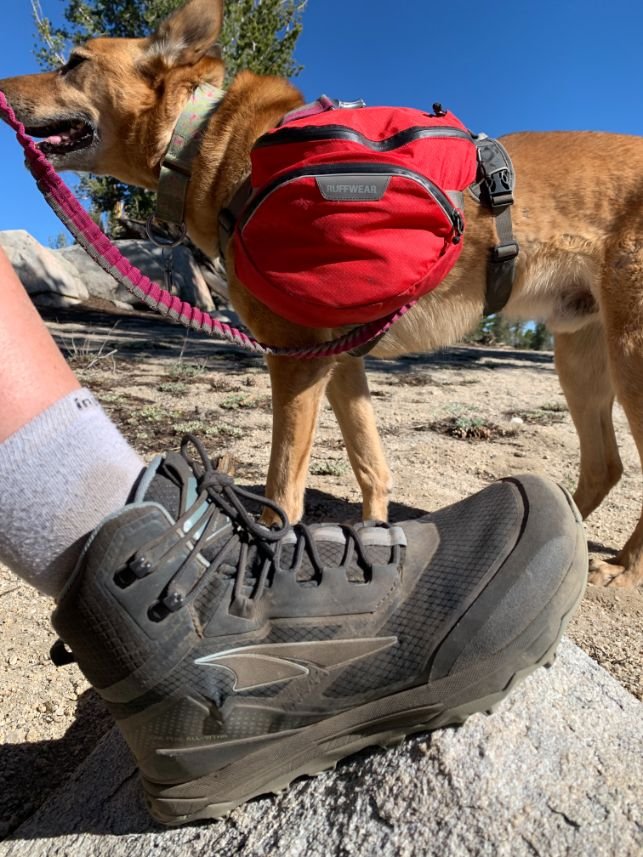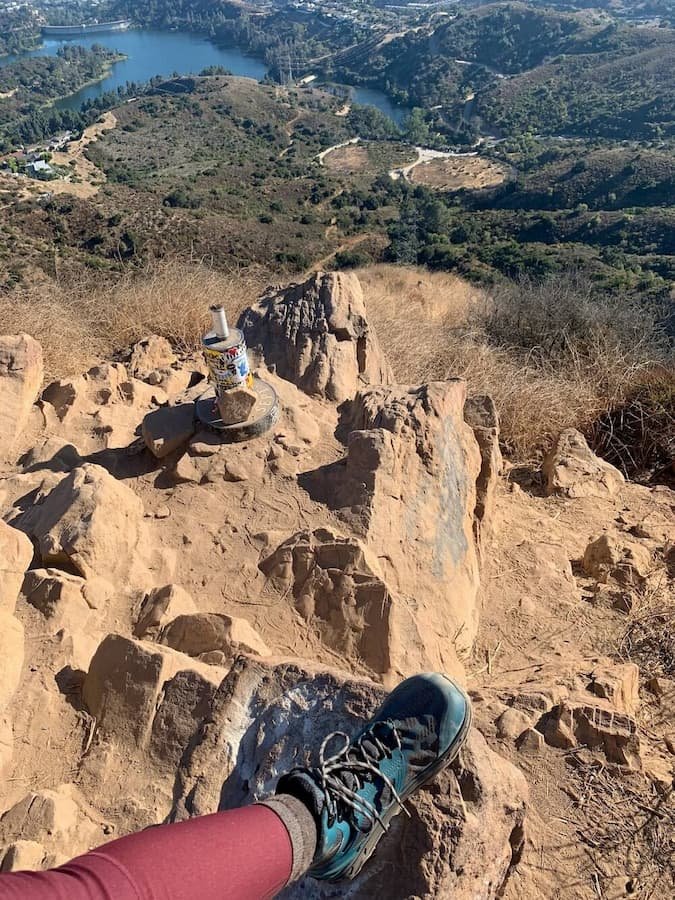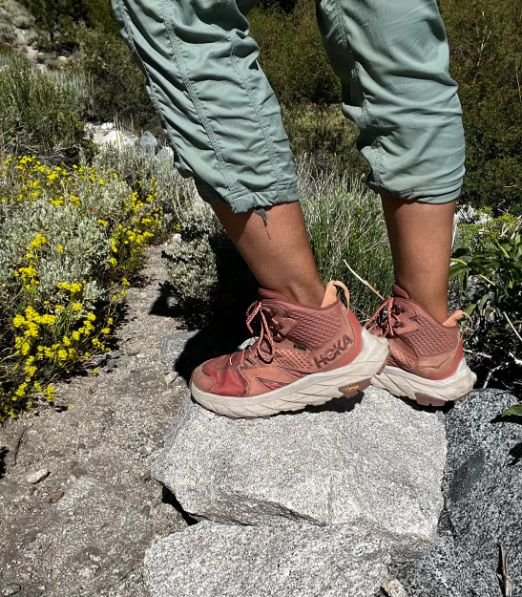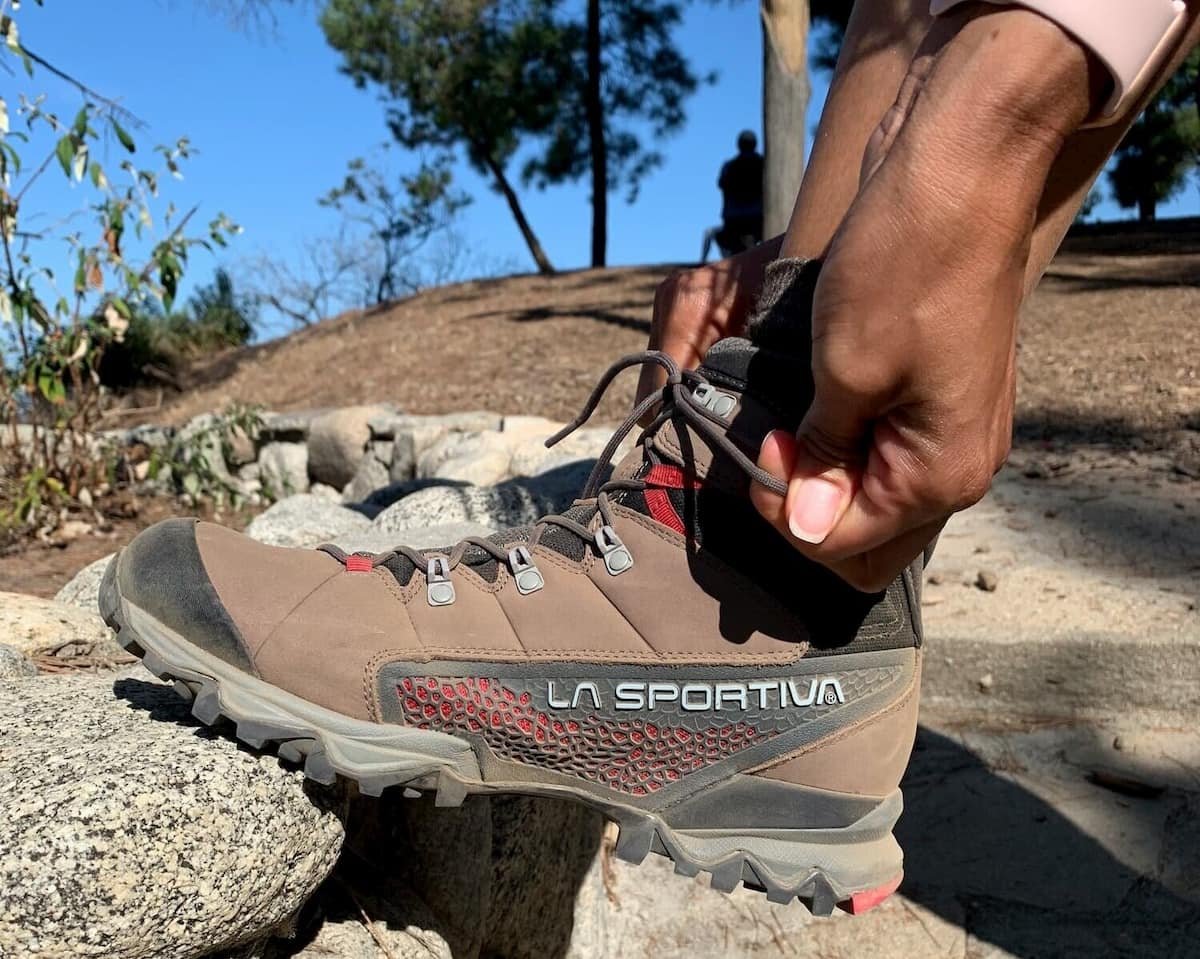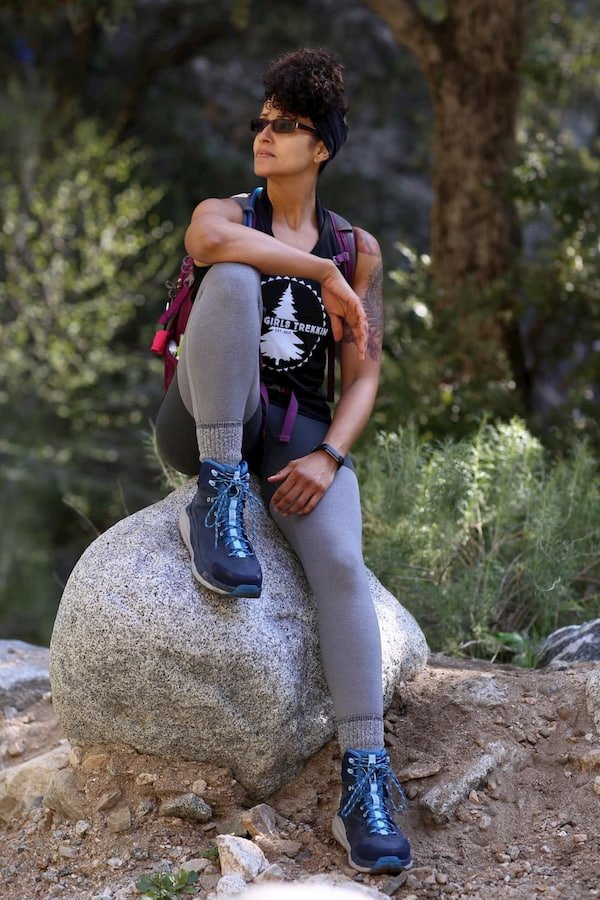Best Lightweight Hiking Boots of 2025
Lightweight, breathable, waterproof hiking boots for day hiking and light backpacking
October 28, 2024
Home > Gear Reviews > Footwear
To find the best lightweight hiking boots for men and women, we started by compiling reviews from reputable media outlets and everyday users. To compare and verify using our own experience, we tested the top 20 lightweight boots over various terrains to get an accurate feel for how they would perform on day hikes that representative of most hikers.
Our goal isn’t to find the one best hiking boot, but to give you an in-depth analysis of each hiking boot so you can find the one that works for your needs.
Whether you need a waterproof pair that can withstand Pacific Northwest rain or ventilated boots that can keep your feet comfortable in desert summer temps, here are our winners for the best lightweight hiking boots currently available.
Want a low-top hiking boot? See our guides to Best Hiking Shoes or Women’s Hiking Shoes.
Want something sturdier? See our guide to Best Hiking Boots. Need something for winter? Check out our guide to best hiking boots for wet and snow.
We create reader-supported, objective gear reviews independently selected by our editors. This story may contain affiliate links, which help fund our website. When you click on the links to purchase gear, we may get a commission — without costing you an extra cent. Thank you for supporting our work and mission of outdoor coverage for every body! Learn more.
Comparison Tables
Women’s
| WOMEN'S HIKING BOOT | TREELINE AWARD | WEIGHT PER BOOT (OZ) | WATERPROOF MATERIAL | SOLE | MSRP* |
|---|---|---|---|---|---|
| Salomon X Ultra 4 Mid Gore-Tex | Best Overall Read why |
13.0 | Gore-tex | All Terrain Contagrip | $175 |
| Hoka Kaha 2 GTX | Most Comfortable Read why |
15.6 | Gore-tex | Vibram Megagrip | $240 |
| Merrell Moab 3 Mid | Best Affordable Read why |
14.5 | None | Vibram TC5+ | $130 |
| La Sportiva Nucleo High II GTX | Best for Narrow Feet Read why |
11.0 | Gore-Tex | Vibram® Nano XS-Trek | $239 |
| Keen Targhee IV | Best for Wide Feet Read why |
17.3 | Keen.Dry | TPU | $170 |
| Altra Lone Peak ALL-WTHR Mid 2 | Best Ultra Lightweight Read why |
12.0 | eVent | DuraTread | $180 |
| Hoka Anacapa 2 Mid GTX | Most Versatile Read why |
14.7 | Gore-Tex | Vibram Megagrip | $195 |
Men’s
| MEN'S HIKING BOOT | TREELINE AWARD | WEIGHT PER BOOT (OZ) | WATERPROOF MATERIAL | SOLE | MSRP* |
|---|---|---|---|---|---|
| Salomon X Ultra 4 Mid Gore-Tex | Best Overall Read why |
15.2 | Gore-Tex | All Terrain Contagrip | $175 |
| Hoka Kaha 2 GTX | Most Comfortable Read why |
18.8 | Gore-Tex | Vibram Megagrip | $240 |
| Merrell Moab 3 Mid | Best Affordable Read why |
17.0 | None | Vibram TC5+ | $130 |
| La Sportiva Nucleo High II GTX | Best for Narrow Feet Read why |
16.8 | Gore-Tex Surround | Vibram® Nano XS-Trek | $239 |
| Keen Targhee IV | Best for Wide Feet Read why |
20.3 | Keen.Dry | Higher-traction TPU | $155 |
| Altra Lone Peak ALL-WTHR Mid 2 | Best Ultra Lightweight Read why |
15.0 | eVent | DuraTread | $180 |
| Hoka Anacapa 2 Mid GTX | Most Versatile Read why |
18.0 | Gore-Tex | Vibram Megagrip | $195 |
*We note any discounts we see on our Deals page, which is updated daily.
The Best Lightweight Hiking Boots
The Best Overall Lightweight Hiking Boots: Salomon X Ultra 4 Mid Gore-Tex
Waterproofing: Gore-Tex
Sole: All Terrain Contagrip
Durability: 5 out of 5 stars
Ankle support: Good
Breathability: 5 out of 5 stars
Fit and size: Runs big
Weight (per boot): 13.0 oz (women’s) / 15.2 oz (men’s)
What we liked: breathability, waterproofing, exceptional traction, incredible comfort right out of the box, no break-in needed
What we didn’t like: runs narrow, available in wide sizing but can be hard to find
The Salomon X Ultra 4 Mid Gore-Tex is our winner for the Best Hiking Boot overall for hikers of all skill levels and foot shapes. The 2024 model is actually even more lightweight than in previous years in the women's model (by 0.5 oz) and this year, has an updated style that we like.
In our own testing, we found these lightweight summer hiking boots to have exceptional traction, good breathability, and feel comfortable right out of the box without a break-in period. For 2024/25, every other boot we tested got heavier except for the Salomon X Ultra 4 Mid GTX. The Salomon X Ultra 4 Mid GTX are versatile boots for most hikers tackling most trails in all climates and terrain.
Compare prices of the Salomon X Ultra 4 Mid Gore-Tex
Men's
Women's
The midsole and relatively high ankle collar contribute to the X Ultra being one of the most supportive boots we tested. Photo courtesy Nicole Snell.
Comfort, stability, and support
The Ultra Mid 4 GTXs were among the most comfortable shoes we tested out of the box.
The Salomon X Ultra are lightweight, breathable hiking boots ideal for summer hikes. They're made of a leather upper that still feels lightweight, which adds to their breathability.
Over months of hiking, they continued to feel sturdy through various trail conditions I took them, including groomed dirt trails, rocks, loose dirt, and incline/declines.
The Salomon X Ultra has a thick Vibram outsole but is lighter in weight than they look. Their traction on both loose dirt and rocks was exceptional. I didn’t feel any rocks poking into my feet as I hiked.
These are some of the best hiking boots with ankle support. No break-in period was needed, and I did not get any rub spots on my feet or ankles despite aggressive inclines and declines
These boots felt true to size with extra room in the toe box. This allowed my toes to spread out when they swelled during and after hiking. I have a narrow foot but one of our wide-footed testers found them to run narrow.
The Salomon Xs are a high-collar waterproof hiking boot. They have webbing eyelets, except for the last 2 hooks that are spaced far apart from each other and the webbing loops. Because of this lacing structure, I didn’t feel like I could get the boots as tight around my ankle as I’d like. While hiking, I notice some gaping between the shoe and my ankle. Although my ankle wiggles around a little, this has never caused me to lose my footing or roll my ankle.
I felt these boots could handle a substantially larger pack than what I carried and still feel comfortable. The reason? The burly midsole and relatively high ankle collar. The result is this lightweight hiking shoe is more supportive than most boots for medium-heavy loads while hiking or backpacking.
We were also pleased with the breathability of these shoes. My feet didn’t feel hot even when I was hiking in temperatures in the 80s. After that day hike, they were only slightly damp inside from sweat.
For more details, see our full, in-depth review of the Salomon X Ultra 4 Mid GTX hiking boots.
Most Comfortable Lightweight Hiking Boots: Hoka Kaha 2 GTX
Waterproofing: Gore-Tex
Sole: Vibram Megagrip
Durability: 5 out of 5 stars
Ankle support: Medium
Breathability: 5 out of 5 stars
Fit and size: Runs 1/2 size big
Weight (per boot): 15.6 oz (women’s), 18.8 oz (men’s)
What we liked: roomy, luxuriously comfortable, supportive, solid, smooth, rugged, cushioning
What we didn’t like: costs a little more than other lightweight boots
After 800+ miles of hiking and backpacking all around the world in these boots, the HOKA Kaha 2 GTX are the best lightweight hiking boots you can get if you're ok spending a little more. After the trail, terrains, and miles I’ve put on my first pair, the Hoka Kaha 2 boots are the most comfortable hiking boots, and we highly recommend them.
The Hoka Kaha 2 is a lightweight leather hiking boot that is the #1 top seller at REI nationwide and among the most popular lightweight boots available. Expert and everyday reviewers agree with me that these are comfortable right out of the box, stable, and have excellent waterproofing and traction.
I've hiked in the Kaha worldwide — from Mt. Whitney to the mountains of Andorra — before retiring them... for a new pair. I consider the HOKA Kaha 2 as the full-size 4WD SUV of hiking boots. Roomy, comfortable, supportive, solid, smooth, and rugged.
These are my go-to boots for backpacking or day hikes longer than 5 or 6 miles. I’m a hiker who enjoys cushiony and comfortable boots while hiking, and HOKA has been one of my favorite brands for hiking boots. See our full, in-depth review of the Hoka Kaha 2 for more info.
Compare Prices of the Hoka Kaha 2 GTX
Men's
Women's
Cushioning
Like many Hoka boots, including the Hoka Anacapa (see review below), the Kaha's extra cushioning helps prevent foot fatigue.
I was initially skeptical about the Hokas because they looked clunky and heavy. But after my first day hike with them, I realized that they were much lighter than they looked and comfortable right out of the box.
The author crossing a log in the Hoka Kaha. Photo by Gina Danza @wildginaa
Durability
I’ve taken these boots on unforgiving trails, dragged my toes across rocks, side-swiped rocks along narrow cliffsides, and had them in conditions that ranged from very hot to freezing.
After hundreds of miles of hiking, there was no cracking or separation and no tears in the full-grain leather, so I know the Kahas can take even the most challenging trail!
Fit and Sizing
When I first tried on the Hokas, I noticed they ran large, at least ½ to ¾ of a size (I wear a size 11). However, I found that the extra space in the Hokas is great for swelling feet and for toes to spread out on descents. Note: I used an after-market insole to help take up some extra space since they have a wide fit. You can learn more in Should I use insoles with my hiking shoes?
REI has the best customer process for exchanging boots for correct sizes. Zappos also offers free returns within 365 days, including shipping box-free and printer-free return options.
Stability
As far as stability goes, these boots have one of the highest collars of all the models we reviewed. The Hoka’s lacing system allowed me to get a firm fit around my ankle. The Kaha has 6 eyelets, which allows me to customize how I tighten the laces to get the firm fit I want.
Traction
The traction is top-notch, and I have yet to have lost traction or a slip. It has a Vibram® Megagrip hi-traction outsole with 5mm lugs. Stability and traction are a big deal for me. I can be clumsy, especially when my brain and feet are tired at the end of a hike. Having this solid traction on the sole makes every step feel secure.
I recently summited Mt. Whitney as part of a section hike this June, and without a 2nd thought, I wore my Kaha. I wore them through 50 miles of backpacking through the Nuumu Poyo trail (the John Muir Trail) from Onion Valley to Mt. Whitney Portal. I wore them through scree, rocks, snow, water crossings, dirt, sand, grass, and mud. These boots got me through all those miles feeling comfortable, supported, and without a single blister (although this was also partly due to my intense anti-blister routine).
In addition to the Nuumu Poyo and Mt Whitney, I've also taken these boots on peaks throughout Southern California and Zion National Park. These boots offer excellent traction in all the terrains I explored: wet rocks, river crossings, dirt, scree, rocks, and steep inclines/declines. I navigated several river crossings where the boots were in the water to the base of my ankle, and my feet stayed completely dry. In fact, I watched the water bead off when I took my feet out of the river.
The Best Budget Lightweight Hiking Boots: Merrell Moab 3 Mid
Waterproofing: None (waterproof versions available)
Sole: Vibram TC5+
Durability: 4 out of 5 stars
Ankle support: Good
Breathability: 4 out of 5 stars
Fit and size: True to size; wide
Weight (per boot): 14.5 oz (women’s), 17 oz (men’s)
What we like: value for the price, variety of sizes and materials to really get what you want, balance of price, comfort, performance
What we don’t like: not as stylish, not quite as supportive or good of traction as other boots
Merrell has been making a version of the Merrell Moab 3 Mid for almost two decades, and it is often considered one of the greatest hiking boots of all time, especially if you’re on a budget.
A big perk of the Merrells over other hiking boots is that they are available in the most variety of materials and sizes of any of the boots we considered.
After testing, we would trust these boots for short and long hikes in varied dry terrain and think they perform just as well for beginner or experienced hikers. We like these boots so much, we wrote an in-depth, long-term review of the Merrell Moab 3, which has even more details.
Compare Prices of the Merrell Moab 3 Mid Hiking Boots
Men's
Women's
The traction on the Merrell Moab is good enough to climbing steep, loose, and sandy terrain. Photo courtesy Nicole Snell.
Sizing
They have wide versions, a good variety of sizes, vegan versions, and all kinds of waterproofing. Whether you need a men's hiking boot, women's boot, or kid's hiking boot — the Moab has options for the whole family (and you can even match colorways if you'd like).
All the boots have that stereotypical “hiking boot look.” Compared to some of the boots we tested, they look bulky (though they are still surprisingly lightweight!).
Still, multiple colors are available to give you options that don’t necessarily scream out, “look, I’m a hiking boot!” if you are wearing them through the city or traveling. Treeline Review writer Gabi Reyes-Acosta wrote about the Unlikely Hikers and Merrell collaboration, which brings more color to the line-up.
Stability and Ankle Support
Out of the box, the Merrell Moab 3 boots felt solid and were much lighter than they looked. They have a mid-collar and all webbing eyelets except for the top eyelet, which is a hook. I liked this feature because I could cinch the laces tighter around my ankle.
Fit and Comfort
I have narrow feet, and these felt just a tad wide, but I liked the little bit of extra space. During testing, my foot didn’t feel like it was moving around inside. They fit true to size. I never got rub spots or discomfort on rugged trails with loose dirt, uneven sections, rocks, and dips. My feet and ankles felt supported and stable.
Traction
The boots have great traction and grip. When I scrambled over rocks and loose dirt, my ankles felt supported. I particularly liked the toe “spikes” at the front of the Moab 2 because it gives extra grip on dirt ascents. The rubber toe cap is also an added layer of durability when bumping into rocks.
Waterproofing and Breathability
One concern about the Merrell Moab is that they are among the heaviest boots we considered. The mesh non-waterproof version I tested still made my feet get sweaty. The waterproof version ranks even lower on breathability.
That waterproof version (men's and women's) is the most popular and best selling and it goes by the name Merrell Moab 3 Mid Waterproof. It uses Merrell's own proprietary waterproofing. Merrell also offers a waterproof version called the Moab 3 Mid GORE-TEX (men's and women's), which uses name-brand waterproofing.
Unless you hike in a wet or cold climate, to get the best breathability, we recommend the original, non-waterproof version (men's and women's).
Best Lightweight Hiking Boots for Narrow Feet: La Sportiva Nucleo High II GTX
Waterproofing: Gore-Tex
Sole: Vibram Nano XS-Trek
Durability: 5 out of 5 stars
Ankle support: Excellent
Breathability: 2 out of 5 stars
Fit and size: Runs narrow and small
Weight per boot: 11.0 oz (women’s), 16.5 oz (men’s)
What we liked: sturdiness, breathability, cushion, easy to lace, significant arch support, great for narrow feet, fit like a glove
What we didn’t like: not a good option for wide feet
For people with narrow feet, the La Sportiva Nucleo High II GTX are our award winners for Best Hiking Boots for Narrow Feet. They were a favorite of our testers for their sturdiness and breathability. They’re cushiony, easy to lace, and have significant arch support. They’re also aesthetically among the more attractive boots we considered.
It is now available in D-medium and E-wide width. Our testers continue to give these shoes glowing reviews. After all these years, our own testers stand by these boots.
Compare Prices of the La Sportiva Nucleo High II GTX Hiking Boots
Men's
Women's
Comfort and Fit
These felt sturdy out of the box, and I loved their styling and color. They felt much lighter than they looked but still sturdy. I liked the design, which gave them a low-profile look for a mid-top light boot.
Although these fit like a glove for my narrow feet, it’s important to mention that those with wide feet may find these are not very forgiving.
Ankle Support and Lacing
The Nucleos and the Hoka Kaha 2s (reviewed above) have the highest collar of all the shoes I reviewed. The Nucleos easily lace up quickly and get a snug fit in the ankle. They have webbing eyelets until the last 2 with one a D ring, and the top is a hook.
These fit true to size, but when I first put them on, I felt like my pinkie toe on my right foot was a little tight. However, this never presented a problem while hiking. My toes felt like they had plenty of room to spread out.
Materials and breathability
The Nucleo is made from a rugged Nubuck leather upper, similar to what you'd find in the Hoka Kaha 2. What makes it different is the incorporation of La Sportiva’s proprietary Nano-Cell mesh along the sides. This helps the boot breathe more like a synthetic hiking boot.
Hiking in the high 70’s, my La Sportiva boots were surprisingly dry inside. Their breathability is excellent. These also work well in all types of hiking and backpacking conditions, including water, mud, and snow.
The La Sportiva Nucleo are comfortable right out of the box. Photo by Nicole Snell.
Traction and cushioning
One feature unique to the La Sportiva is the “impact brake system,” a section of hard rubber on the sole at the back of the heel. I tested the La Sportiva Nucleos through varied terrain throughout Southern California. I was impressed by how cushioned and soft each step felt. It always felt like there was significant arch support like I was walking on memory foam. They felt sturdy on uneven terrain, and there was excellent ankle support with plenty of traction and grip.
The Nucleos were comfortable out of the box and continue to be comfortable during subsequent hikes. However, I think it may be prudent to take them on a short hike before taking them on something longer/more technical to address any tongue/lacing concerns.
The bottom line
I would recommend the La Sportiva Nucleo boots to any hiker, whether beginner or advanced. In addition, the quality of the material and thickness of the sole would make these more than capable of supporting a heavier pack or longer hikes.
Best Lightweight Hiking Boots for Wide Feet: Keen Targhee IV Waterproof Mid
Waterproofing: Keen.Dry
Sole: Higher-traction TPU
Durability: 4 out of 5 stars
Ankle support: Minimal
Breathability: 4 out of 5 stars
Fit and size: Runs 1/2 size small
Weight per boot: 15.0 oz (women’s), 17.0 oz (men’s)
What we like: sturdy construction, breathability, wide size availability, durability, affordability, features friendly for beginner hikers and more advanced backpackers means you can grow skills with this boot
What we don’t like: not as stylish, less arch support, low collar
Whether you’re a beginner hiker or need something that can handle longer hikes and a heavier pack, we think the Keen Targhee IV Waterproof Mid are the best hiking boots for hikers with wide feet. The Targhees were among the most breathable boots we tested and the most affordable.
We liked that the Keen Targhee IV has design features that appeal to beginner hikers and advanced backpackers, meaning you can grow your hiking skills with this shoe.
Beginner hikers will appreciate extra protection that makes them feel solid and sturdy. I like that it has a solid rubber toe cap that comes up pretty high on the top of the shoe because I tend to snag my toes on rocks while hiking. But the new bonded sole and upper and shock absorption cushioning is thick enough to handle a heavier pack and long hikes by advanced hikers. The Keen Targhee IV are a crowd-pleased, especially for hikers with wider feet.
Read our full review on the KEEN Targhee IV for more info.
Compare Prices of the Keen Targhee IV Waterproof Mid
Men's
Women's
The Keen Targhee II are a solid and sturdy lightweight boot. Photo courtesy Nicole Snell.
Fit and Comfort
Keens are famous for fitting wide feet, which I was initially concerned about because I have narrow feet. But when I tested, I liked that there was enough space in the toe box for my toes to spread out while hiking.
The Keens were not as right-out-of-the-box comfortable as some other hiking boots we tested. On our first hike, we noticed they offer less arch support than other boots we tested, but an aftermarket insole can fix that. On subsequent hikes, we found once the Keens are broken in, they form more to an individual's foot and ankle shape.
Ankle Support
The Keens are made of leather and have the lowest collar of all the boots we tested. They have webbing eyelets except for the last hole, which is a hook. It made the lacing fast, but we never felt like we could get a really tight fit around the ankle.
Traction
During testing, the Keens felt stable with excellent traction on loose dirt. My feet never felt hot hiking in these shoes, even on days that were in the mid-80s. They stayed dry on the inside, even on warm days. We found that the Targhees are among the most breathable boots we tested.
Waterproofing and durability
The Targhee IV uses proprietary Keen.Dry material that helps keep the price down over Gore-Tex.
The newest model is constructed for better durability, addressing a waterproof leaking issue in the previous version. It won’t delaminate and has a midsole that resists compression. The new outsole is twice as abrasion-resistant as rubber. According to Keen, it withstands 1 million flexes (500 miles) without failing. We haven't put in 500 miles (yet!) but will report back.
The Lightest Hiking Boots: Altra Lone Peak All-Wthr Mid 2
Waterproofing: eVent
Sole: DuraTread
Durability: 2 out of 5 stars
Ankle support: Minimal
Breathability: 2 out of 5 stars
Fit and size: Feels narrow
Weight (per boot): 12 oz (women’s), 15 oz (men’s)
What we liked: lightweight, great option for hikers and backpackers who typically use a low hiking shoe or trail runner and need a boot for more support, ankle protection, or in snow and high water
What we didn’t like: Zero drop takes getting used to, not much support or stability compared to other boots
The updated Altra Lone Peak ALL-WTHR Mid 2 are our winner for the best ultra lightweight hiking boots. At 12 ounces per shoe, they’re the lightest hiking boot we considered that performed very well. The Altra Lone Peak mid offers impressive performance for their weight, making them the best hiking boot for ultralight hikers.
These lightweight boots are great for hikers who typically wear trail runners but want a lightweight boot for more support, ankle protection, or in snow and high water. Although the price has gone up, the update improves on earlier models with better ankle support, stability, and better waterproofing.
Compare Prices of the Altra Lone Peak All-Wthr Mid 2
Men's
Women's
For many hikers new to Zero Drop shoes, it’s worth taking the Altra Mids on some flatter terrain to accustom your feet to the design. Photo courtesy Nicole Snell.
Materials
The Lone Peak ALL-WTHR Mids are made of synthetic material and are the only vegan shoe we considered. This explains the more flexible feel and lighter weight. Hikers who prefer a trail running shoe to a boot may appreciate these features, but most who already use boots or are buying their first pair will find this a drawback.
Comfort
While the Altras are a good option for those who want Zero Drop shoes for performance or medical reasons, we found the Altras Mids are most comfortable for hikers already used to wearing trail runners, low hiking shoes, or Zero Drop shoes.
Although the Altras initially feel comfortable right out of the box, there’s a transition period to get used to Zero Drop walking. Hikers new to Zero Drop are likely to find that a few miles into their first hike, they may feel less comfortable than in other hiking boots.
The Altra Lone Peak ALL-WTHR Mid still looked new after 175 miles of backpacking the Tahoe Rim Trail. Photo by Sara Kruglinksi.
Stability and Support
One tester, who normally hikes and backpacks in trail running shoes, found the support to be a notable improvement, especially for long and heavy carries of 7 to 8 liters of water and carrying extra food and gear for a canine companion. However, most hikers who already use boots or are buying their first pair may not find it enough support.
The Altra Lone Peak ALL-WTHR could handle the weight of a backpacking pack filled with water and gear for a human and dog. Photo by Sara Kruglinksi.
Fit
The newest model has a narrower toe box. You can still get them in wide sizing, too. The narrowed toe box improves upon the bulkier profile from the previous model, making these boots look sleeker. This helps with how often testers noted bumping their toe against rocks.
The generous footbox on this older model of Altra Lone Peak Mid. Photo courtesy Nicole Snell.
Lacing and Ankle Support
The Altra Lone Peak ALL-WTHR Mids have a mid-collar ankle with combination eyelets with webbing and D-rings. There are no hooks at the top of the eyelets, which made it difficult for one tester to get a tight fit around the ankle.
However, we found a lot of benefits to this simple lacing system. We could slide in and out of these boots almost as easily as trail runners, making them ideal for late-night potty breaks while backpacking or airing out the feet at lunch and snack breaks.
We were concerned the height might cause blisters or rub our feet differently. But even after 14 days of backpacking, we did not get any blisters or have any uncomfortable rubbing.
Traction on the Altra Lone Peak ALL-WTHR mids. Photo by Sara Kruglinksi.
Traction
We found the traction on rocks from the new midsole to be excellent. However, the rubber sole is much thinner than other hiking boots. Our tester, who doesn't typically wear zero drop shoes, said, "I felt every bump and rock in the trail, which became uncomfortable over time." However, our tester, who typically hikes in trail runners, didn't find it an issue.
Waterproofing and Breathability
Altra mids have a waterproof membrane made of eVent. When our tester walked across the stream crossings, our feet stayed nice and dry inside the shoes. We still had several snow fields to cross in late June, and our feet stayed dry in the snow crossings. The heavy lugs on the bottom of the shoes provided lots of traction in the slippery summer slush.
Both our testers found that the waterproof membrane makes the shoes hotter to wear on high heat days.
The bottom line
The Lone Peak ALL-WTHR Mid II is a specialized boot that appeals to a niche but fanatic audience. Whether this boot will work for you depends on your body and needs. If unsure, see our How to Choose section below for questions to ask yourself when choosing a boot.
Most Versatile Hiking Boots: Hoka Anacapa Mid GTX
Waterproofing: Gore-Tex
Sole: Vibram Megagrip
Durability: 5 out of 5 stars
Ankle support: Medium
Breathability: 5 out of 5 stars
Fit and size: Runs 1/2 size big
Weight (per boot): 14.7 oz (women’s), 18 oz (men’s)
What we like: cushioning, traction, better for urban use, more affordable and lightweight than other Hokas
What we didn’t like: lacing doesn’t dial in fit as well as other Hokas, material isn’t as sturdy as other Hokas
If the Hoka Kaha is the full-size 4WD SUV of hiking boots, the Hoka Anacapa Mid GTX is the crossover SUV of hiking boots. They're versatile, light, flexible, dependable, and responsive. Both provide incredible traction and support your step through technical terrain, but the Anacapa is lighter, better for urban use, and more affordable. I take my Anacapa boots on hikes under 8 miles, but they could certainly handle a longer trek. I’ve taken both boots through rocky trails, scree, water crossings, dirt, and grassy areas. For more info, check out our in-depth, long-term review of the Hoka Anacapa 2 Mid GTX.
Compare Prices of the Hoka Anacapa 2 Mid GTX
Men'S
Women's
The Anacapa is a lighter weight Hoka hiking boot. Photo courtesy Nicole Snell
Hoka Anacapa vs Hoka Kaha
One of the main differences I noticed between the Hoka Kaha 2 (review above) and Anacapa is the material of the uppers and midsoles. The Anacapa uppers and midsoles combine waterproof nubuck leather with recycled polyester materials in the collar, mesh, and laces. In contrast, the Kaha 2 is made of full grain waterproof leather, which adds increased durability and stability while hiking.
The combination of nubuck and polyester makes the Anacapa lighter when you move. I noticed that the boot material would flex down into the top of my foot when stepping, causing discomfort. To address this, I adjust the tongue and readjust the laces.
Waterproofing
The Gore-Tex waterproof material in the Anacapa, much like in the Kaha, works well on numerous water crossings, and my feet don’t get uncomfortably sweaty.
The Hoka Anacapa is a hiking boot that has many of the same features as the Hoka Kaha, but is lighter weight and more affordable. Photo courtesy Nicole Snell
Cushioning
The Anacapa boots has a lighter cushioning than the Kaha, and due to their lighter weight, it almost feels like you’re wearing a shoe instead of a boot.
Traction
The traction on the Anacapa is the same as the Kaha — top-notch, and I have yet to have either boot be the reason for lost traction or a slip. Both have a Vibram® Megagrip hi-traction outsole with 5mm lugs. The Anacapa also has an extended heel that adds to the traction.
The bottom line
Both the Anacapa and Kaha are solid boots that I highly recommend. The Kaha is my preference for longer hikes and backpacking due to the boot material, cushioning, and lacing structure. But if you prefer a boot that is lighter, more responsive in the mid & upper, and quicker to lace, then the Anacapa will serve you well.
other lightweight hiking boots we tested
Keen Terradora II (Women’s Only)
Waterproofing/Sole: Keen.Dry
Sole: Carbon rubber
Durability: 2 out of 5 stars
Ankle support: Low
Breathability: 3 out of 5 stars
Weight: 12.8 oz (per boot)
While these boots were promising, their big brothers, the Keen Targhee II or Keen Targhee III, have more fabric and sole options and generally higher reviews. We found the sole too soft and flexible for a hiking boot.
View the Keen Terradora II
Salomon Quest 4 Mid GTX
Waterproofing: Gore-Tex
Sole: Contagrip TD
Durability: 4 out of 5
Ankle support: High
Breathability: 3 out of 5
Weight (per boot): 19.2 oz (women’s), 23.2 oz (men’s)
We tested the Salomon Quest Mid GTX for our Best Hiking Boots guide, which covers heavier-duty boots. We still think it's a great boot — just not as lightweight as the boots in this guide.
Salomon Quest 4 Mid GTX
Men's
Women's
Lowa Renegade GTX Mid
Waterproofing/Sole: Gore-tex
Sole: Vibram Evo
Durability: 4 out of 5 stars
Ankle support: High
Breathability: 3 out of 5 stars
Weight (per boot): 17 oz (women’s), 19.5 oz (men’s)
We tested the Lowa Renegade GTX Mid for our Best Hiking Boots guide, which covered heavier-duty boots. We still think the Lowa Renegade is a classic boot that is a great winner, but it wasn't light enough to meet our criteria for this guide.
Lowa Renegade GTX Hiking Boots
Men's
Women's
Keen Targhee III
Waterproofing/Sole: Gore-tex
Sole: Rubber
Durability: 4 out of 5 stars
Ankle support: High
Breathability: 3 out of 5 stars
Weight (per boot): 22.2 oz (women’s), 19.5 oz (men’s)
We tested the Keen Targhee III to compare it to the Keen Targhee II we recommend.
The waterproofing on the Targhee III is better, but all testers found the fit on the Targhee II to be better–especially people who want wide hiking boots. We think it's more important to have a better fitting hiking boot than one that is more waterproof.
The flatter heel has less of a drop than the Targhee II. Keen describes the Targhee III as “feeling more like a sneaker” with trail-runner like lugs. The Targhee III has a contoured fit and more streamlined design with less internal volume, meaning it is less generous in the toe box and less wide than the Targhee II. Nonetheless, it is nearly 5 oz heavier than the Targhee II. We think for wide-footed hikers, the Targhee II is a better choice.
Keen Targhee III Hiking Boots
Men's
Women's
Xero Shoes Scrambler Mid II WP
Waterproofing/Sole: eVent BIO laminate
Sole: Michelin FiberLite Sole
Durability: 4 out of 5 stars
Ankle support: Low
Breathability: 4 out of 5 stars
Weight (per boot): 10 oz (women’s), 12 oz (men’s)
The Xero Shoes Scrambler Mid II WP boots are a zero-drop minimalist lightweight hiking boot. It is breathable and features Michelin rubber traction that is sticky on rock. Durability-wise, it lives up to the brand's 5,000 mile warranty. It's available as a breathable mesh or waterproof version and are now PFAS-free.
Although the soles gripped well on the trail, they still performed best on well-maintained trails. Since these shoes have thinner soles and less support than traditional hiking boots, off-trail travel or exceedingly difficult terrain would be difficult, but they still perform really well for minimalist shoes on this kind of terrain.
See our full, in-depth review of the Xero Shoes Scrambler Mid II WP.
View the Xero Shoes Scrambler Mid II WP
Men's
Women's
Keen Targhee II
Waterproofing/Sole: Gore-Tex
Sole: Rubber
Durability: 4 out of 5 stars
Ankle support: High
Breathability: 3 out of 5
Weight (per boot): 22.2 oz (women’s), 19.5 oz (men’s)
“Targhee II or Targhee III?” is a common question. Now that the Keen Targhee IV is out, we only think you should opt for these older versions if you are on a budget.
Keen even explains the differences on their blog and why they still sell both models. The Targhee II continues to be available for good reason—it serves a different purpose than the Targhee III. Most hikers (including our testers) find the Targhee II has better comfort and fit than the Targhee III. The Targhee II has more room in the toe box. It also has an elevated heel so feels more like what most people associate with hiking boots.
The Targhee III is designed to have a more contoured and streamlined fit in the toe box that Keen describes as fitting “more like a sneaker” with trail-runner like lugs. The flatter heel has less of a drop. The Targhee III has less internal volume, meaning it is less generous in the toe box and less wide than the Targhee II. The waterproofing on the Targhee III seemed better in our tests, too.
Ultimately, for hikers who want a wide shoe, the Targhee II is the clear winner.
View the Keen Targhee II
Men's
Women's
The author hiking in the San Gabriel mountains in the Hoka Kaha boot. Photo by Liz Thomas.
How we Researched and Tested
To provide the most comprehensive information available, we sourced our information from numerous 3rd party review sites and hundreds of customer reviews. When details were scarce, or we required more information to make an informed evaluation, we dug deeper into customer reviews on Amazon, Zappos, REI, and Backcountry. From dozens of boots, we personally tested the Top 10 on dozens of day hikes in Southern California, a thru-hike of the 175-mile Tahoe Rim Trail, and backpacking and hiking trips from Utah to the mountains of Europe in the winter.
First, we analyzed hundreds of expert and customer reviews to discover what features people prefer on their lightweight hiking boots (and what annoys them, too).
This story shows you how we identified the best hiking boots. Based on those metrics, we created a section where you can answer questions to determine whether a hiking boot is for you.
Deciding on footwear can be an extremely personal experience since we all have different foot shapes, physiology, past injuries, and expectations of comfort. For this reason, our review breaks down all the contenders into various categories so you can make an informed decision with all available information for your specific needs.
Read more about How to Choose Lightweight Hiking Boots and the criteria we used to judge lightweight hiking boots. For more info, see How to Choose Hiking Boots Expert Advice from REI.
We researched the most popular and highest rated hiking boots from 15 different websites. Then we personally tested the top picks. [Pictured: La Sportiva Nucleo] Photo courtesy Nicole Snell
Buying Advice
The author on the summit of Ontario Peak in the San Gabriel mountains. Photo by Liz Thomas.
The most important thing you should know is that the best hiking boots for you are the ones that feel comfortable and fit your foot well. All the hiking boots we recommend meet the criteria we set. However, when deciding which of our recommended picks is the best boot for you, we suggest looking at our How to Choose the Right Lightweight Hiking Boots for questions to ask yourself on what is most important to you in a boot.
After poring through hundreds of reviews on hiking boots, we narrowed the list of dozens of light hiking boots to our top picks. We based those picks on the following criteria. We ranked the criteria from the most important features to ones that would be nice to have but not a deal-breaker if they were missing.
1. Comfort
Being comfortable out of the box with little to no break-in period was a major factor in considering which boots to review. It was also paramount that the boots maintained comfort throughout the shoe's life.
2. Weight
We wanted to keep our top picks in the lightweight shoe range, so we aimed for models that were 1 pound or less per boot. In comparison, the traditional leather boot can be 2 or even 3 times as much in weight.
3. Traction
One of the hallmarks of a good hiking boot is its ability to keep you stable and provide an excellent grip on various types of trail conditions, including sand, rocks, scree, dirt, mud, or wet rocks. We chose models that ensured excellent traction. We compared the materials in the rubber outsole of each shoe to see how they performed in muddy, slippery, sandy, and rocky terrain.
While we were familiar with Vibram sole before we started doing this research, it's becoming common for shoe companies to use their own proprietary rubber sole.
To determine whether each model could take rocky trails and rugged, technical terrain, we compared our own testing with what customers reported back.
4. Price
Price will inevitably be a factor in what boots a buyer will consider. The majority of these boots are under $200. However, since many of the higher-priced boots still came with exceptional features, we didn’t use these criteria to eliminate higher-priced boots from consideration.
5. Breathability
Although a waterproof membrane like Gore-Tex can reduce the breathability of a boot, we chose most of the models to strike a balance between the two. We chose boots whose breathability is not overly compromised by the waterproof membranes so that they provide sufficient ventilation regardless of the outside temperature of the hike.
6. Durability
Hiking boots must last through rough terrain, various weather conditions, hike lengths, water crossings, and time. We consulted long-term customer reviewers and added our own testing feedback to determine the durability over time of these boots.
7. Waterproofness
Based on our research, most people looking for a lightweight hiking boot want something with a waterproof membrane. Even if you live in a dry part of the world, it is beneficial to have a waterproof boot so that a chance rainstorm doesn’t ruin your hike...or your hiking shoes! All of our top picks have a waterproof option.
We also understand that some outdoors people do not like waterproof hiking shoes or don’t want to pay extra for waterproofing. For that reason, we note when our top shoe models are also available in non-waterproof options. Consider a waterproof hiking shoe if you'd like something lighter but still want waterproof footwear. All our picks in our Best Hiking Shoe story are available with waterproofing.
8. Ankle Height
All boots we selected are low to mid in height. We looked for boots that balance ankle support and ease of movement.
9. Cushioning
Hiking boots use an EVA midsole to cushion your feet from feeling the ground or the shock of movement. Their main role is shock absorption; though you can't always see it, they're often the first part of a lightweight boot to get worn out. A backpacking boot tends to have a stiff midsole (see our Best Hiking Boots story if a backpacking boot is more your jam).
A mountaineering boot has a very stiff sole and is intentionally rigid. A hiking shoe will use a more flexible midsole (see our hiking shoe story if that's more your style). A trail runner usually has a very flexible midsole (see our best women's trail running shoes and best men's trail running shoes guides). And lastly, a day hiking or lightweight backpacking boot is the Goldilocks of the footwear category: it has a semi-stiff EVA midsole
How to Choose the Right Lightweight Hiking Boots for You
Choosing a pair of hiking boots can be intimidating with all the available options, features, materials, colors, and styles. This guide will make this process less stressful and more fun so you can feel confident picking a pair that will serve your needs and help you get out and enjoy the outdoors! And don’t forget to take care of your feet!
Quiz Yourself: Find the Perfect Boot for Your Next Adventure
1. How Wide or Narrow is Your Foot?
If you have a wide foot and your shoe fits too tightly, you risk getting blisters and rub spots. If you have a narrow foot and your shoe fits too loosely, your shoe may feel less stable or supportive.
For folks with narrow feet, we recommend boots with a narrow fit or medium-width shoes that can be laced up tightly. When boots are too wide, your foot can slip and slide inside and cause blisters. You can compensate for too-wide boots by wearing thicker socks or using insoles to fill the extra space. Read more about the benefits of using special insoles with hiking boots here.
For folks with wider feet, we recommend choosing a model available in a Wide Fit. Another trick we recommend for folks with wider feet is if you normally wear women’s shoes, you can opt for a men’s version of the same model to get wider hiking shoes.
The Keen Targhee IV (read review above) is our recommended boot for wide feet. In testing, we also found the Hoka Kaha 2 or Salomon X Ultra Mid 3 GTX to run wider than normal. Customer reviews aggregating findings from hundreds of users agree that these boots are wider than average. We also recommend the Merrell Moab 3 Mid (review above) because it is available in wide options.
If your foot is on the narrow side, the La Sportiva Nucleo II won our award for Best for Narrow Feet (review above). According to customer reviews and our own testing, these boots have a narrow fit. We also suggest the Merrell Moab 3 in their narrow sizing (review above).
2. Do You Need Waterproofing?
Are you going to be hiking the dusty Southwestern deserts? Lush mountains in the Pacific Northwest? If you plan to take your boots through mud, puddles, and water crossings, or you live in a rainy location, chances are that you’ll want a waterproof boot.
Our research shows that people who purchase lightweight hiking boots tend to prefer those with waterproofing. If you live in a dry part of the world with little chance of hiking through rain or a water source, you can probably get away with a non-waterproof option. Waterproofing is a preference, so we mention when waterproof and mesh options are available for each model of boot we review.
3. How Much Do You Want to Spend?
If cost is your main concern, we suggest the Merrell Moab 3 Mids (review above), the most affordable boots we found that fit all of our criteria and the winner of our Best Budget Lightweight Hiking Boot award. The Keen Targhee IV Mids (read review above) are also reasonably priced and received higher ratings on 3rd party review sites than the Moabs.
If price is not a concern, we think you may find higher-end models more comfortable straight-out-of-the-box and over the shoe's life. These pricier boots offer additional features and received higher ratings from outdoor media and customers.
4. How Technical is Your Hiking?
Are you planning a multi-day backpacking trip in the Sierra? Or are you interested in day hiking an urban trail like Runyon Canyon in Los Angeles? If you are a beginner hiker and plan on exploring well-maintained dirt or only semi-rocky trails, we suggest the Altra Lone Peak ALL WTHR Mid 2 (review above) or the Merrell Moab 3 Mid (review above).
Are you tackling more technical trails or rugged terrain? Using a heavier pack or backpacking? Or exploring more rough terrain? You may want a boot with more traction and more durable materials. We suggest looking at the Hoka Kaha 2 (review above) or Salomon X Ultra 4 Mid GTX (review above).
Customers also reported that the Keen Targhee IV Mid was a solid choice for non-technical and technical hiking and backpacking. However, not all reviewers found them comfortable right out of the box.
5. What is the Lightest Weight Boot?
Most light hiking boots are less than one pound per shoe. The goal of a light hiking boot is to give you the support of a heavier boot in a lighter-weight material and design. Wearing lighter-weight hiking shoes can reduce foot or leg fatigue, which is a criterion valued by beginner and experienced hikers.
If your goal is to have the lightest weight boot possible, the Altra Lone Peak ALL WTHR Mid 2 leads the pack (review above) at a low 10.6 ounces per boot. That’s one reason it is popular with weight-obsessed thru-hikers, even though some hikers find it lacks the technical abilities of other boots.
For a bit more weight that is offset by more cushioning and durability, we recommend the Hoka Kaha 2 (review above) at 15.6 oz per boot or the Keen Targhee IV Mid (review above) at 15.0 oz per boot.
6. What Sizes are Available?
Most boots we reviewed had Women’s sizes from 5 to 11 (1/2 sizes available) and Men’s sizes from 7 to 14. If you have a larger foot, we recommend the Salomon X Ultra 4 Mid GTX (review above) and Altra Lone Peak ALL-WTHR Mid 2 (review above), available up to a women’s size 12.
For men, the Altra Lone Peak ALL-WTHR Mid isavailable up to size 15, and the Keen Targhee IV Mid is available up to size 17.
7. Do Colors Matter to You?
Your boots are going to get dirty anyway, right? But that doesn’t mean your feet can’t look fabulous at the start of every hike and after a good cleaning! Every boot we recommend comes in various colors to fit various style preferences.
If color and style are a high priority, we suggest you try the Keen Targhee IV Mid, which has 4 color options. The Merrell Moab 3 Mid comes in 6 colorways.
8. Are You Vegan?
If you’re vegan, you may want to avoid boots made with leather upper or suede. If that’s your story, look at boots made of synthetics, nylon, and mesh.
We suggest the Altra Lone Peak ALL-WTHR Mid 2 (review above). All the other boots in this review contain leather or suede materials.
9. Do You Want or Need a Zero Drop Boot?
Zero drop shoes or boots allow the foot to sit level with the ground. The heel and forefoot are at the same distance from the ground with no slope in between.
If you know that you need such a feature either due to injury, muscle imbalance, or performance recommendations, the only boot on our list that offers this is the Altra Lone Peak ALL-WTHR Mid 2 (review above).
Do I Need Hiking Boots to Hike?
Hiking boots are an essential part of your outdoor trekking, hiking, and adventuring experience and will help you get the most out of your time on the trail. A solid hiking or backpacking boot will allow you to walk comfortably for miles over technical terrain with either a day pack or overnight pack. Hiking boots keep your feet supported, stable, and dry on the trail.
We chose to review light hiking boots vs. a full mountaineering boot because they are a great introduction for beginner or day hikers who don’t want a lot of extra weight on their feet and want to start using them right out of the box with little or no break-in period.
Light hiking boots are also a great option for experienced hikers who want versatility in their hiking gear for doing less technical trails or carrying a lighter pack. Lightweight boots can often double as backpacking boots, too, if your load is light.
See our Best Hiking Boots story if you’re interested in a more sturdy hiking boot than we cover in this article.
Or, if you’re looking for the best lightweight hiking shoe (lower collar with less ankle support), we cover low-top shoes designed for hiking in its own story: see our Best Hiking Shoe story.
Or, if you want something for a fast and light adventure, see our guides to Best women's trail running shoes and Best men's trail running shoes.
Should I Get Hiking Boots or Hiking Shoes?
The first question is first. Not sure whether you want a light hiking boot, heavier hiking boot, or hiking shoe?
We interviewed experts, including a Canadian Mountain Guide, to determine when boots work best and when you can get away with shoes in our hiking shoe story: Hiking Boots vs Shoes vs Trail Runners.
Think you want a heavier boot? Looking for extra stability, durability, or support? See our How to Choose a (heavier) Hiking Boot story.
FAQ
Are lighter hiking boots better?
Lighter isn’t necessarily always better when it comes to hiking gear, but weight savings is something many hikers consider with their gear, including boots. There is always a balance between weight, durability, and features, and depending on your priorities, you may choose to favor one over the other.
But there are important advantages to lightweight hiking boots. Generally, the less your gear weighs, the less energy you expend on the trail, footwear included. Heavy boots will inevitably make your legs more tired over many miles of hiking, so lighter boots that still offer durability, traction, and other features that are important in hiking boots are often a top choice for hikers. Similarly, lightweight hiking boots can also be more comfortable to wear on the trail.
Does hiking boot weight matter?
Just like any hiking and backpacking gear, weight matters with your boots. The weight of hiking boots is often balanced with other features, like durability, and it’s important to have a combination of both. The heavier your hiking boots are, the more effort each step on the trail will take. Having a pair of boots that are both functional and lightweight is important for hikers to have comfort and endurance on the trail. Always consider the weight of the boots along with other features when you’re looking for a new pair.
Is it OK to wear hiking boots in the summer?
Different types of hiking boots can be worn throughout every season. Some are made specifically for winter and cold weather, while others are meant for summer and warm weather adventures. Lightweight hiking boots are especially ideal for summer because that weight savings often helps to make them more breathable. If you’re looking for hiking boots to use in the summer, ensure they’re a 3-season, non-insulated boot (like any of the ones in this review).
Will hiking boots stretch?
Most hiking boots, especially ones made with leather, will stretch and break in over time. The change is usually not drastic, but it’s something to consider when trying on and selecting boots. It’s still crucial to ensure the boots fit well out of the box. If they feel too small, they typically will not stretch enough to be comfortable, especially if the length is not right.
Can hiking boots get wet?
You’ll inevitably encounter mud and water on the trail at some point, and hiking boots are made to be outside in it all. Not all hiking boots are waterproof, but whether they are or not, getting them wet generally will not ruin them. If your boots aren’t waterproof and you do get them wet, it’s best to let them dry out as soon as possible, more for the sake of your feet than anything else. Some boots (like lightweight ones made with synthetic materials) dry faster than others (like heavier, full-leather boots).
Do you size up or down for hiking boots?
It’s best to try on boots before buying, if possible, or ensure that there is a good return or exchange policy if you’re buying online. Boot sizing can vary by brand (some run small, while others might run large or true to size). You don’t want your toes ramming the front of the boot, but you also don’t want so much room that your heel slips, creating a greater potential for blisters. If you’re on the fence between sizes, it’s better to size up to keep your toes happy.
When you try on boots, wear the socks that you'll be hiking in. Hiking socks are usually thicker than everyday socks, and you'll need room for them.
Also, keep in mind that your feet will expand as you hike. Many hikers find that their feet will grow by at least ½ size during a hike, depending on the mileage and weather conditions (heat tends to exasperate this issue).
Other Things You Need When You Buy Hiking Boots
For each hike testing these lightweight hiking boots, I wore Smartwool Light Hiking Socks (men’s and women’s) and carried a light daypack (the Osprey Tempest 20, weighing about 10 pounds). My feet are a women's size 11, and I have narrow with low/no arches.
Hiking Socks
A good pair of hiking socks is as important as having a good pair of boots. They can prevent blisters and make any pair of boots feel more comfortable. See our story on The Best Hiking Socks for our suggestions.
Boot Laces
At some point in your hiking career, you will need extra laces. Most boot laces will work, but if you choose the Salomon boots, note that they require special Kevlar laces.
Insoles
Hikers of all levels often add additional insoles like Superfeet or Sole Footbeds. You can learn more in Should I use insoles with my hiking shoes?
Gaiters
Gaiters are a great way to keep dirt, rocks, or water out of your boots. For those who know they want gaiters, the Altra Lone Peak ALL-WTHR Mid have built-in gaiter attachments on each boot to make using them easier.
Hiking Boot Care and Maintenance
Hiking boots can last for years if they are well maintained. After each use, wipe off dirt with a damp cloth. If your boots are leather, you can use a leather lubricant from time to time to keep the material supple, so it doesn’t dry out.
If your boots get wet during your hike, loosen the laces, open the tongue, and let them fully dry inside your dwelling or a shady area outdoors. You can stuff them with paper towels to absorb the extra moisture if they are saturated inside. Just be sure to change the paper towels frequently, or it defeats the purpose! Don’t leave them out in the sun or in front of a heat source to dry, as this can warp the shoe.
Author’s Expertise / Why You Should Trust Us
The author testing a pair of Hoka One One Sky Kaha boots. Photo by Gina Danza@wildginaa
I’m Nicole Snell — a hiker, speaker about hiking, and the owner of Girls Fight Back, a women’s self-defense company. I’m the creator of Outdoor Defense, an IGTV series about staying safe while enjoying the outdoors.
I’m also an outspoken advocate for hiking and protecting our natural lands. I am a hike leader for Black Girls Trekkin, which focuses on Diversity, Inclusion, Conservation, and Education. I taught a Runner’s World Online Virtual Workshop on self-defense for the Runner’s Alliance (Women’s Health Magazine and Runner’s World).
Since a young age, exploring and hiking have been my passion. I grew up outside Joshua Tree National Park and spent my childhood exploring the nearby desert and rocks.
As an adult, I have continued that passion. I have hiked all over the world, including Japan, New Zealand, South Korea, Scotland, Wales, Andorra, and the infamous 4 Day Inca Trail to Machu Picchu in Peru.
I was an Outdoor Adventure Summit Speaker, a Summer Solstice Workshop Speaker with AdventureUs, and a Rise.Run.Retreat Women’s Running Retreat speaker. I also won a Webby Award for People’s Voice for Tastemade Travel’s Self Defense for Female Travelers. I’m part of the Difference Makers Collaborative Partnership and a Women’s Self Defense Summit speaker. I’ve presented a trilingual workshop on Hiking Emergency Preparedness at the Los Angeles Natural History Museum Camp Out and Outdoor Preparedness at the Stoneview Nature Center.
I’ve been a frequent podcast guest for talking about safety while hiking and have been featured on the: Nike Trained podcast, Tough Girl podcast, Jazzed About Nature podcast, The Mend podcast, Womxn of the Wild podcast, and the Almost There Adventure Podcast.
Over the years of exploring trails and mountains, I have owned many pairs of hiking footwear. Because of my experiences on numerous trails, I can appreciate and evaluate the various features that light hiking boots offer in the different brands and models.
You can read all of Nicole Snell's articles on her author page
Sources
How to find hiking community: Melanin Basecamp

